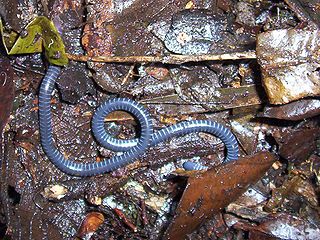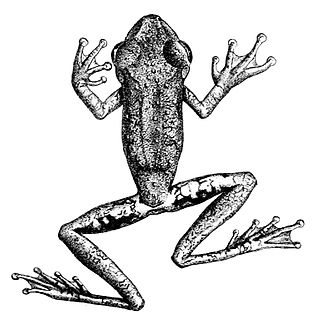
Caecilians are a group of limbless, vermiform or serpentine amphibians. They mostly live hidden in the ground and in stream substrates, making them the least familiar order of amphibians. Caecilians are mostly distributed in the tropics of South and Central America, Africa, and southern Asia. Their diet consists of small subterranean creatures such as earthworms.
Indotyphlus maharashtraensis is a species of caecilians described in 2004 by scientists of Bombay Natural History Society and the Natural History Museum, London. It is only the second species of Indotyphlus known to science, and only known from its type locality near Humbarli village, Satara District, in the Western Ghats of Maharashtra, India. Common names Humbarli caecilian, Maharashtra caecilian, and Konkan tail-less caecilian have been coined for it.

Boulengerula taitana is a species of caecilian. It is endemic to the Taita Hills region of southeast Kenya.

Boulengerula is a genus of amphibians in the family Herpelidae. They are found in East Africa. They are sometimes known as Boulenger's caecilians or Usambara bluish-gray caecilians.
Boulengerula denhardti is a species of amphibian in the family Herpelidae. It is endemic to Kenya. It is only known from its type locality, the Tana River valley, as well as from the Ngaia Forest, Meru County. It is named for German explorer brothers Clemens Denhardt and Gustav Denhardt who explored the area where it was discovered. Its natural habitats are subtropical or tropical moist lowland forests and heavily degraded former forest. It is threatened by habitat loss, expanding agriculture, use of herbicides and pesticides and expanding human settlements.
Boulengerula fischeri is a species of caecilian in the family Herpelidae. It is endemic to Rwanda and only known from around its type locality near Cyangugu, southwestern Rwanda. The specific name fischeri honours Eberhard Fischer, a German botanist who has worked with Rwandan fauna and flora. Common name Fischer's African caecilian has been coined for it. Live animals have the appearance of "live pink spaghetti".

Chthonerpeton exile is a species of caecilian in the family Typhlonectidae. It is endemic to Brazil, and only known from its imprecise type locality "Bahia". Only one specimen is known and now lost. The specific name exile, form Latin exilis, refers to the "relatively slender, delicate shape of the body and head." The common name Bahia caecilian has been coined for this species.
Herpele multiplicata is a species of caecilian in the family Herpelidae. It is endemic to Cameroon. It is only known from its holotype, which is now lost. The only available information is the brief species description published in 1912 by Fritz Nieden. Common name Victoria caecilian has been coined for it.

Herpele squalostoma is a species of caecilian in the family Herpelidae. It is also known by the common name Congo caecilian. It is found in Central and extreme easternmost West Africa.
Mimosiphonops vermiculatus is a species of caecilian in the family Siphonopidae. It is endemic to Brazil and known with certainty only from its type locality, Teresópolis in the Rio de Janeiro state. Common name worm-patterned caecilian has been proposed for this species.

Siphonops annulatus, the ringed caecilian, is a species of caecilian in the family Siphonopidae from South America. It might have the broadest known distribution among terrestrial caecilian species.

Dryaderces inframaculata is a species of frog in the family Hylidae. It is endemic to Brazil and known from between the Tapajós and Xingu Rivers in Pará. Until recently, it was only known from one specimen collected near Santarém, probably around 1876, by Henry Wickham. Common name Santarem treefrog has been coined for it.
Phrynopus montium is a species of frog in the family Craugastoridae. It is endemic to Peru and only known from two localities near Cascas in the Junín Region: "Cascas near Huasahuasi", the imprecisely known type locality where the types were collected in 1936, and south of Hacienda Cascas, where it was found in 2014. Records from the PascoPasco and Huánuco Regions refer to Phrynopus kotosh and Phrynopus oblivius, respectively. Common name Cascas Andes frog has been coined for this species.
Cryptotriton monzoni is a species of salamander in the family Plethodontidae. It is endemic to Guatemala and known only from near its type locality, Cerro del Mono near La Unión, Zacapa Department. The specific name monzoni honors José Monzón, a Guatemalan entomologist who helped the authors with the fieldwork. Common name Monzon's hidden salamander has been coined for it.
Gegeneophis is a genus of amphibians in the family Grandisoniidae. They are found in southern and northeastern India.
Microcaecilia iwokramae is a species of caecilian in the family Siphonopidae. It is endemic to Guyana and only known from its type locality in the Iwokrama Forest. It was first described as Caecilita iwokramae in the monotypic genus Caecilita, before being recognised as belonging to Microcaecilia.
Gegeneophis primus is a species of caecilian discovered in Wynad district in the Western Ghats of Kerala, India. The species was described in 2012 by Ramachandran Kotharambath, Mark Wilkinson, and colleagues.
Ichthyophis moustakius, the Manipur moustached caecilian, is a species of caecilian in the family Ichthyophiidae. It is endemic to Northeast India. This species exhibits broad lateral yellow stripes from the anterior part of its tail, along its mandibles, between its nares, as well as elsewhere. The animal can reach a length of 300 millimetres (12 in). Its head is somewhat U-shaped and fairly short; scales are absent on its collars. The species' name is derived from the Greek word moustakius, meaning "moustache", due to the yellow arched stripes it possesses.
Ichthyophis khumhzi, the Khumhzi striped ichthyophis, is a species of caecilian found in India. It has narrow and irregular lateral yellow stripes. It can attain lengths larger than 400 mm (16 in). Its head is V-shaped while short; the animal shows scales as far anterior as its collars. The species is named after Khumhzi village, where the specimens were first collected.

Ichthyophis kodaguensis, also known as the Kodagu striped Ichthyophis, is a species of caecilian in the family Ichthyophiidae. It is endemic to the southern Western Ghats, India. All confirmed records are from southern Karnataka state, although it is also reported from adjacent Kerala.







